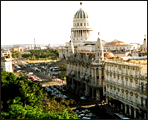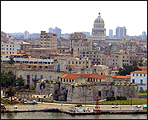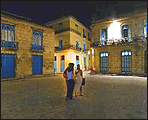|
The town of San Cristóbal de La Habana ,  or simply Havana , was one of the first seven villages founded by the Spaniards in the island of Cuba . It was most probably named after the Indian chief Habaguanex, head of the aboriginal settlements of that zone by the time the Spanish conquerors arrived. The present location of the city was not its original one. In the year of 1515, Diego Velázquez ordered its foundation in the southern coast of today’s province of Havana and there is a hypothesis that there was a second settlement by the margins of the Almendares River . or simply Havana , was one of the first seven villages founded by the Spaniards in the island of Cuba . It was most probably named after the Indian chief Habaguanex, head of the aboriginal settlements of that zone by the time the Spanish conquerors arrived. The present location of the city was not its original one. In the year of 1515, Diego Velázquez ordered its foundation in the southern coast of today’s province of Havana and there is a hypothesis that there was a second settlement by the margins of the Almendares River .
The excellent characteristics of the Carenas Port ,  today’s Havana ’s Harbor, surrounded then by precious wood forests and fruit trees, propitiated the establishment of the city on its western side and its further expansion around the bay. On November 16 th, 1519 , the incipient town was founded with the celebration of the first mass and first chapter under the shade of a silk-cotton tree where in 1828 the Templete (little temple) would be erected, just across from the Arms Square . today’s Havana ’s Harbor, surrounded then by precious wood forests and fruit trees, propitiated the establishment of the city on its western side and its further expansion around the bay. On November 16 th, 1519 , the incipient town was founded with the celebration of the first mass and first chapter under the shade of a silk-cotton tree where in 1828 the Templete (little temple) would be erected, just across from the Arms Square .
The city would soon start to flourish and quickly became a commercial town par excellence. By the 17 th Century, Havana had the most renowned shipyard in the New World . Given the exceptional geographical location of the bay, Havana would soon become a point of merchandise traffic and a gathering port for the Spanish fleet that would depart from Havana carrying gold and silver from the whole continent each September. The “Key of the New World ” attracted more and more the attention of pirates and privateers that besieged it constantly. In 1553, Havana became the capital of the country once the Spanish Governor moved to it from Santiago de Cuba . The town acquired the title of city in 1592, upon completion of the most important public work of the 16 th Century: the Zanja Real (royal ditch), which constituted the first aqueduct of the city. became a commercial town par excellence. By the 17 th Century, Havana had the most renowned shipyard in the New World . Given the exceptional geographical location of the bay, Havana would soon become a point of merchandise traffic and a gathering port for the Spanish fleet that would depart from Havana carrying gold and silver from the whole continent each September. The “Key of the New World ” attracted more and more the attention of pirates and privateers that besieged it constantly. In 1553, Havana became the capital of the country once the Spanish Governor moved to it from Santiago de Cuba . The town acquired the title of city in 1592, upon completion of the most important public work of the 16 th Century: the Zanja Real (royal ditch), which constituted the first aqueduct of the city.
 In 1538, just after the city had been destroyed by a pirate attack, it was decided to start the construction of the Castillo de la Real Fuerza, one of the most emblematic fortresses of the city. Nevertheless, the city was attacked again and set in fire in 1550. Havana had to be fortified and to that aim, the Spanish government erected castles, towers, and walls placed in key points that would allow the protection of the city. Examples are: the iconic Castillo de los Tres Reyes Magos del Morro, the entrance gate to Havana’s harbor and an unmissable guide for seamen thanks to its elegant lighthouse; San Salvador de la Punta, which closes the entrance to the bay together with El Morro; the majestic San Carlos de la Cabaña; the biggest Spanish fortress in the Americas; the turrets of San Lázaro and la Chorrera, watching points outside the limits of the old city; and the wall, enormous stone ring around the city. In 1538, just after the city had been destroyed by a pirate attack, it was decided to start the construction of the Castillo de la Real Fuerza, one of the most emblematic fortresses of the city. Nevertheless, the city was attacked again and set in fire in 1550. Havana had to be fortified and to that aim, the Spanish government erected castles, towers, and walls placed in key points that would allow the protection of the city. Examples are: the iconic Castillo de los Tres Reyes Magos del Morro, the entrance gate to Havana’s harbor and an unmissable guide for seamen thanks to its elegant lighthouse; San Salvador de la Punta, which closes the entrance to the bay together with El Morro; the majestic San Carlos de la Cabaña; the biggest Spanish fortress in the Americas; the turrets of San Lázaro and la Chorrera, watching points outside the limits of the old city; and the wall, enormous stone ring around the city.
Prior to the construction of the fortress of La Cabaña and the consolidation of the port of Havana as the safest in the Spanish colonies of the Americas , the city was besieged and seized by the English fleet after a fierce resistance in 1762. After eleven months of English government, Havana was returned to Spanish rule in exchange for Florida and the city continued to grow very quickly.
During the 17 th and 18 th centuries slave trade was a key factor for the export of products such as sugar and tobacco. In the city, the Real Compañía de Comercio de La Habana monopolized and concentrated all the commerce of the country and that of the Caribbean . After the end of the English occupation, free commerce was adopted and the city gained an economical momentum. Population and urban growth brought about the expansion of the city and in the 19 th Century, the wall around the ancient city had to be demolished.
Intramural Havana or Old Havana has witnessed relevant events in Cuban history: In 1853, the birth of José Martí, who would be in time one of the fathers of Cuban independence, in one of its narrow streets; in 1871, the execution of eight innocent medicine students to avenge the supposed profanation to the grave of a Spanish colonial officer; in 1898, the blowing in Havana’s harbor of the American warship Maine, which triggered the Spanish-American War and the consequent American occupation and control of the country; and in the first half of the 20 th Century, the struggle of Cubans against the corrupt governments of the neo-colonial republic.
In spite that Havana has been, from the 19 th Century on, much more than that intramural Havana, the oldest district of the city has continue to be in the center of economical, political, historical, and cultural development of Havana City.
|